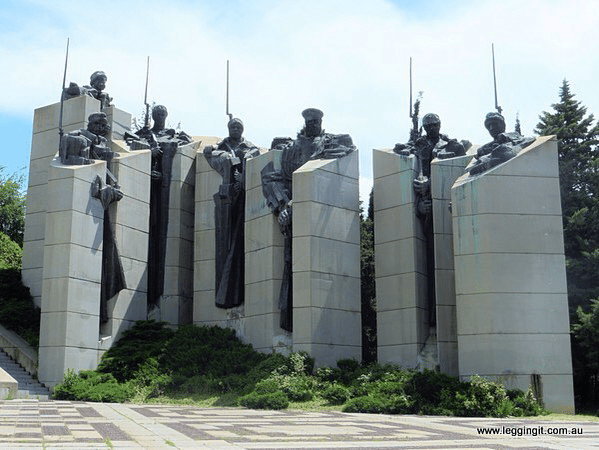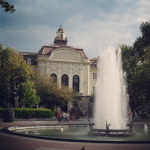After spending yesterday dodging the rain, today we’re back on the road heading from Veliko Tarnovo. It was pretty hard packing the bike as the hotel owner and his next door neighbour we intensely watching every move I made. Of course by the time I’d packed everything and strapped everything down Michele arrived with my runners. Oops time to take it all back off and pack it again. A few minutes later we were set to go and we were waved off with a “watch out for the potholes”. It’s a traditional Bulgarian greeting…… Well it should be 😉
In the streets on the outskirts of Plovdiv there are some monster potholes. Some are big enough to train for the Olympics in. They are ones to avoid on a bike as they are definitely show stoppers.
The navigator reported that the satnav was flat so we stopped off at the Golden Arches for breakfast with a side order of free wifi. Strangely they don’t have breakfast menu, it’s just a normal menu. After checking out the route and a burger we headed off. The satnav was put on charge in the fairing as we headed out of town. Asking directions off the navigator she started having a tantrum. Yes I’d looked at google maps on the phone so why didn’t I know the route. Well when I’d suggested to mount the GPS my idea had been poo pooed. Once again the satnav was flat and the navigator was leaving the navigating up to me. Luckily I could just make out the highway numbers and a town on the large scale map of Europe.
Just out of Plovdiv I turned onto highway 8 and headed in the direction of Burgas on the road to Svelingrad. About 20 km’s out of Plovdive the road branched off onto highway 772 towards Burgas and Stara Zagora. Along the main highway the road signs are in Cyrillic and English but further out in the country everything’s in Cyrillic. Luckily I am getting used to reading it so deciphering Старa Загора (Stara Zagora) wasn’t too hard.
The countryside was just magnificent with low rolling hills covered in all sorts of crops, including corn, wheat, canola, okra, beans, cabbages. The most beautiful was a field of poppies. We’ve seen poppies growing amongst other crops but never a sea of red such as this. It was lovely passing through such rich farming country however, a few cabbage moths became victims of my helmet visor. One thing we’ve missed seeing whilst in Turkey is rivers full of water. In Turkey the water is diverted for irrigation and hydro electricity so seeing rivers flowing again is a real treat.
Since the downfall of communism Bulgaria has relied heavily on agriculture. As we’ve passed through many towns lots of the old factories are abandoned and overgrown with chimneys no longer pumping out smoke. The economy has taken a hit with the average worker supposedly earning about 20 Let per day. However, it seems the biggest industry is gambling with casinos everywhere. Unemployment is high, especially amongst young people, and on the edge of Stara Zagora we started noticing lots of young girls working as prostitutes on the side of the road.
Stara Zagora

We passed through Stara Zagora and after getting our bearings headed towards Novo Zagora (Ново Загора). Here we found the monument we were looking for, ctually it’s hard to miss it.
The Defenders of Stara Zagora Memorial Complex is a massive concrete and steel monument built in 1977, dedicated to the 14,500 local citizens who lost their lives on July 31st 1877 during the Russo-Turkish War. The memorial has statues in concrete of a Russian Officer and six locals, representing the six local volunteer units who joined with the Russian Army to fight against the Ottomans. The Bulgarians battling a larger Ottoman Army were defeated and surrendered. Stara Zagora was then looted and burnt over a three day period, as was the custom for Ottoman soldiers, and 14,500 local citizens were killed. Above the memorial an abstract concrete and tile flag flies. The size of the monument has to be seen to be believed, it’s Brutalist Architecture at its finest.
Kazanlak
Leaving Stara Zagora we headed towards Kazanlak, situated in a valley famous for roses. Around the area huge fields of roses are grown for oil and use in all sorts of products. Kazanlak is the main producer of rose oil and Bulgaria supplies 80 percent of the worlds demand. Of course around the area there’s lots of shops selling all the different rose products. Around the centre of Kazanlak the town is quite nice but as soon as you reach the suburbs you realise it is a pretty hard bitten looking town with lost of grubby old communist style apartment blocks, gypsies driving horse carts and hard bitten looking people.

Apart from roses Kazanlak is famous for its Thracian Tomb discovered in the 1960’s. As the area looked a bit dodgy Michele decided to go in whilst I minded the bike.The tomb which dates back to the 4th century BC is built on a rocky hill and consists of three chambers. One for necessary items such as slaves, chariots and horses, another for storage of other necessary items, and of course one for the body.
The tomb was decorated with fine paintings of the funeral feast, horses, people using white, ocre, blue and black. After paying 3 Let Michele discovered that she didn’t actually get to visit the tomb but a mock up. She squeezed into the small chamber and looked at the various art. It was a long way to divert to see a reproduction. I’d read that it was a mock up so I wasn’t surprised.
Meanwhile I’d tried to start the bike but the battery was playing up so had found a cafe to contemplate push starting it whilst enjoying a coffee. After Michele returned I told her the news and she wasn’t happy at the prospect of pushing the bike. Luckily it actually started and we were able to head off.
The road out of Kazanlak took us through some older areas where mud brick buildings and fences still stood. We also caught a glimpse of the Buzladza, the Flying Saucer shaped monument to the first socialist meeting high on the mountain overlooking Kazanlak. We had hoped to check it out but the rain clouds looked really heavy over it.
Also from the road we got glimpses of the golden domes and huge spire of Shipka Memorial Church. It was built in 1902 on the site where Russian, Ukrainian and Bulgarian forces finally defeated the Ottomans.
The ride up over the mountains surrounding Kazanlak was wonderful with the road winding through forests of pine and deciduous trees. The road over the back of the mountain wasn’t so good with all sorts of bitumen band aids making it quite dangerous.
On the road to Veliko Tarnovo we past a few small towns looking pretty shabby with vacant factories. However, the Bulgarian countryside was just stunning.
Veliko Tarnovo
When we arrived in Veliko Tarnovo we soon found the guest house and rang the bell………no response. Forty minutes of ringing, knocking on the window and kicking the gate followed. We made enough noise to wake the dead but obviously not loud enough to wake the owner. Unfortunately my phone was flat so we couldn’t ring so with grey clouds gathering we did the next best thing. Found free wifi at McDonalds and an intensely sweet strawberry shake.

Another guesthouse in Veliko Tarnovo was promptly booked and soon we were bumbling over the cobblestones of General Gurko Street. It was named after the Bulgarian General who led the liberation forces down this street after the defeat of the Ottomans. It’s a great street full of old renaissance buildings overlooking he river and the four kings monument. After settling into the guesthouse we took a look around Gurko Street and wound up at a lovely traditional pub. It was a great setting and we dined on homemade Bulgarian meatballs, and Tarator (a cold soup made of yogurt, water, cucumber, dill, garlic, and spots of sunflower oil).
After dinner we had a walk around town before heading back to the guesthouse. The frogs in the river below us are so loud that we had to close all the windows and we could still hear them. Tomorrow we are taking a free walking tour of Veliko Tarnovo which we are really looking forward to.






